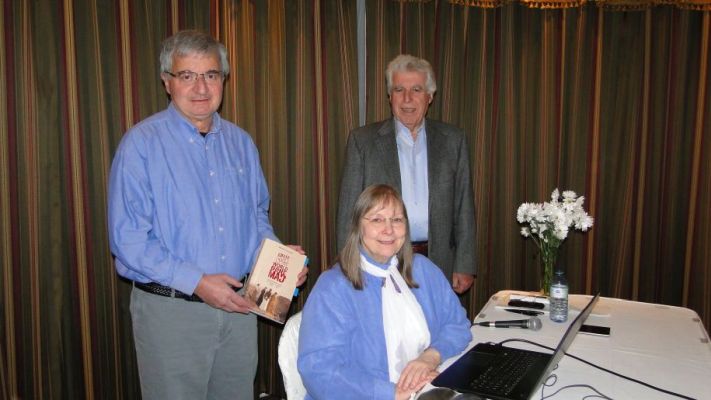February 15, 2019
On November 28, 2018, AGBU Toronto hosted a presentation of a newly published book entitled “Grit and Grace in a World Gone Mad: Humanitarianism in Talas, Turkey 1908-1923” by Canadian writer Wendy Elliott. The book is based on the personal history of a dedicated group of American and Canadian missionaries and relief workers who saved thousands of orphans during the times of the Armenian Genocide.
The presentation was organized within the framework of series of AGBU events to coincide with the UN’s “International Day of Commemoration and Dignity of the Victims of the Crime of Genocide and of the Prevention of this Crime.”
I first met Wendy Elliott in Yerevan where she had gone for development work on behalf of Canada. She had also worked in Gyumri and Vanadzor, and I knew she had a great affinity for the Armenian people. Years later when I came across the unpublished personal archives of Susan Wealthy Orvis, an American missionary in Talas, Turkey, I asked Wendy to write a book about Susan’s story. She declined because she did not believe she could add much to the already large collection of books about the genocide. However, after I urged her to read some of Susan’s letters and a manuscript about her journey across Russia in 1917 to help establish a relief centre, Wendy changed her mind. She had never before heard of this massive humanitarian effort that Canadians and Americans were part of, and decided everyone today should know about this important endeavour.
Wendy told the Toronto audience that another reason for writing the book was to answer a puzzling question for herself: How could the Ottoman Empire go from the joy of the 1908 Young Turk revolution to horrible desecration and genocide in a mere 7 years? She quoted a letter from a young missionary in Constantinople who wrote to her family in the US, describing the euphoria of nations living together in harmony immediately after the revolution: “Last Sunday Turks, Christians and Jews in one wagon were seen singing and embracing and congratulating one another,” said the missionary. “People can scarcely take time to sleep for their joy.” Wendy then spoke about her research into how the government began to change and how the situation went from bad to worse. To write the story, she put herself in the shoes of everyone in the book, including the Ottoman leaders, Enver and Talat Pasha. “I thought, if I were them, I would be terrified to go down in history as the guys who lost the empire. And as it turned out, their fears were realized. But governing by fear produces bad results. During the time period of this book I counted 2 coups d’état, 4 regional wars, 2 genocides (Armenian and Assyrian), and a world war, followed by a war of independence and another genocide (Greek). I thought: The world had gone mad!” That phrase was turned into the book’s title.
Grit and Grace in a World Gone Mad starts with the background of Susan Wealthy Orvis and her American and Canadian colleagues who were employed in Talas by the American Board of Commissioners for Foreign Missions. “Theirs was the largest mission in Turkey, covering an area about twice the size of Switzerland,” the author said. “The Talas station included a hospital, a boys’ boarding school and a girls’ boarding school, and there were 32 outstations, where the ordained ministers would visit as part of their evangelical touring.”
She then described the deportations and massacres in the Talas region, and the ultimate expulsion of the missionaries, too, between 1915 and 1917. The American Committee for Armenian and Syrian Relief (ACASR) set up relief centres in Port Said, Egypt and in Alexandropol (Gyumri), Echmiadzin and Yerevan, which were then part of Russia. At that time, the Ottoman government would not let international aid into Turkey. In 1919 after the Great War, ACASR became known as Near East Relief, and the missionaries—now relief workers—were joined by other humanitarian workers and finally allowed to bring relief supplies to Turkey.
The author showed photographs and read passages from her book about the overwhelming need of the mainly women and children for food, clothing and medical help. She described many details about the work of the humanitarians, who established orphanages and created clothing industries that employed hundreds and clothed thousands. Wendy felt it was important to include stories of righteous people as well. “The term ‘righteous’ was first used by Jews to refer to non-Jews who saved Jews during World War II. Its definition is ‘action taken arising from an outraged sense of justice’. There are many examples in the book of righteous Turks, Kurds, Arabs and fellow Christians, such as Greeks, Americans, Canadians and others, who risked their lives to save Armenians.”
The number of orphans in the Talas mission fluctuated during the four years of the war of independence, but by 1922 there were 3,000. When the political situation suddenly changed, and Christians were “invited” to leave Turkey, the Talas team rolled up their sleeves and, within 10 harrowing days, evacuated 3,000 orphans: the Greek children by boat to Greece, and the Armenians by train to Beirut. “Susan was justifiably proud to say that all the children arrived safely at their destinations,” said the author. “The missionaries had started their mission believing they were going to save souls, but they ended up saving lives—and the seeds of future generations.”
It took Wendy Elliott almost four years to do extensive research, write the book, and arrange publication. The publisher is Gomidas Institute in London, UK. The book received endorsements by Canadian filmmaker Atom Egoyan, professor emeritus of the Royal Military College of Canada Alan Whitehorn, journalist and executive at Voices of Dialogue Kumru Bilici, secretary-general emeritus of the International Red Cross and Red Crescent George Weber, and Bishop Terry Brown. I wrote the foreword.
The book is available for purchase on Amazon and directly from the publisher’s web site.
by Kamo Mayilyan

